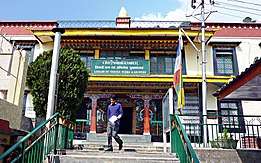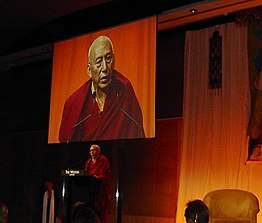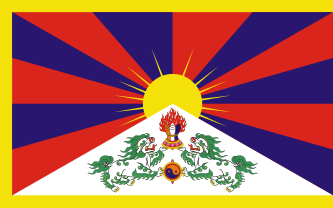Central Tibetan Administration
The Central Tibetan Administration (Tibetan: བོད་མིའི་སྒྲིག་འཛུགས་, Wylie: bod mi'i sgrig 'dzugs, THL: Bömi Drikdzuk , Tibetan pronunciation: [ˈpʰỳmìː ˈʈìʔt͡sùʔ], literally Exile Tibetan People's Organisation)[1] or CTA is an organisation based in India. The CTA is also referred to as the Tibetan Government in Exile which has never been recognized by China,[2] however it is recognized by most Tibetans world-wide. The Tibetan diaspora and refugees support the CTA by voting for members of Parliament, the President and making annual financial contributions through the use of the "Green Book." Its internal structure is government-like; it has stated that it is "not designed to take power in Tibet"; rather, it will be dissolved "as soon as freedom is restored in Tibet" in favor of a government formed by Tibetans inside Tibet.[1] In addition to political advocacy, it administers a network of schools and other cultural activities for Tibetans in India. On 11 February 1991, the CTA became a founding member of the Unrepresented Nations and Peoples Organization (UNPO) at a ceremony held at the Peace Palace in The Hague, Netherlands.[3][4]
Central Tibetan Administration བོད་མིའི་སྒྲིག་འཛུགས་ Bod mi'i sgrig 'dzugs / Bömi Drikdzuk | |
|---|---|
Anthem: Gyallu | |
| Status | Government in Exile |
| Headquarters | 176215, Dharamshala, Kangra district, Himachal Pradesh, India |
| Official languages | Tibetan |
| Religion | Tibetan Buddhism |
| Type | Government in exile |
| Government | |
• Sikyong | Lobsang Sangay |
• Speaker | Pema Jungney |
| Legislature | Parliament in Exile |
| Establishment | 28 April 1959 |
| Currency | Indian rupee (de facto) (INR) |
Website tibet | |
Position on Tibet
The territory of Tibet is administered by the People's Republic of China, a situation that the Central Tibetan Administration considers an illegitimate military occupation. The position of the CTA is that Tibet is a distinct nation with a long history of independence. The position of the People's Republic of China holds that China is multi-ethnic and that Tibetans are among the recognised nations, that the central government of China (throughout its incarnations) has continuously exercised sovereignty over Tibet for over 700 years, that Tibet has not been independent but its de facto independence between 1912 and 1951 was "nothing but a fiction of the imperialists who committed aggression against China in modern history".[5]

Funding
The funding of the CTA comes mostly from private donations collected with the help of organizations like the Tibet Fund, revenue from the Green Book (the "Tibetan in exile passport")[6] and aid from governments like India and the US.[7][8]
The annual revenue of the Central Tibetan Administration is officially 22 million (measured in US dollars), with the biggest shares going to political activity ($7 million), and administration ($4.5 million). However, according to Michael Backman, these sums are "remarkably low" for what the organisation claims to do, and it probably receives millions more in donations. The CTA does not acknowledge such donations or their sources.[9]
The United States have funded the CTA as well in some periods. According to a Chinese source, between 1964 and 1968, the U.S. provided 1.735 million dollars each year.[10][note 1]
In 2012, the Tibetan Policy Act of 2002 was passed in the U.S. to subsidize the CTA.[11][12] In 2016, the United States Agency for International Development (USAID) awarded a grant of US$23 million to CTA.[13] In 2017, U.S. President Donald Trump proposed to stop aid to the CTA in 2018.[14] Trump's proposal was criticized heavily by members of the Democratic Party like Nancy Pelosi[14] and co-chair of the bipartisan Tom Lantos Human Rights Commission Jim McGovern.[15]
Headquarters

The CTA is headquartered in McLeod Ganj, Dharamshala, India. It claims to represent the people of the entire Tibet Autonomous Region and Qinghai province, as well as two Tibetan Autonomous Prefectures and one Tibetan Autonomous County in Sichuan Province, one Tibetan Autonomous Prefecture and one Tibetan Autonomous County in Gansu Province and one Tibetan Autonomous Prefecture in Yunnan Province[16] – all of which is termed "Historic Tibet" by the CTA.
The CTA attends to the welfare of the Tibetan exile community in India, who number around 100,000. It runs schools, health services, cultural activities and economic development projects for the Tibetan community. More than 1,000 refugees still arrive each year from China,[17] usually via Nepal.[18]
Green Book
Tibetans living outside Tibet can apply at the CTA office in their country of residence for a personal document called the Green Book, which serves as a receipt book for the person's "voluntary contributions" to the CTA and the evidence of their claims for "Tibetan citizenship".[19]
For this purpose, CTA defines a Tibetan as "any person born in Tibet, or any person with one parent who was born in Tibet." As Tibetan refugees often lack documents attesting to their place of birth, the eligibility is usually established by an interview.[19]
Blue Book
The Blue Book or Tibetan Solidarity Partnership is a project by Central Tibetan Administration, in which the Tibetan Government in exile issues any supporter of Tibet who is of age 18 years or more a Blue Book. This initiative enables supporters of Tibet worldwide to make financial contributions to help the administration in supporting educational, cultural, developmental and humanitarian activities related to Tibetan children and refugees. The book is issued at various Tibet offices worldwide.[20]
Internal structure

The CTA operates under the "Charter of the Tibetans In-Exile", adopted in 1991.[21] Executive authority is vested in the Sikyong (also known as the President) an office currently held by Lobsang Sangay, who was elected in 2011. The Sikyong is supported by a cabinet of ministers responsible for specific portfolios. Legislative authority is vested in the Parliament of the Central Tibetan Administration.
The Central Tibetan Administration's Department of Finance is made of seven departments and several special offices. Until 2003, it operated 24 businesses, including publishing, hotels, and handicrafts distribution companies.
At the time of its founding, the Dalai Lama was head of the Central Tibetan Administration. Over the ensuing decades, a gradual transition to democratic governance was effected. The first elections for an exile parliament took place on 2 September 1960. The position of Sikyong was later empowered to share executive authority with the Dalai Lama. The Sikyong was initially appointed by the Dalai Lama, but, beginning in 2001, this position was democratically elected by the Tibetan exile voters. The first elected Sikyong was a 62-year-old Buddhist monk, Lobsang Tenzin (better known as Samdhong Rinpoche), to the position of Prime Minister of the CTA.[22] On 10 March 2011, the Dalai Lama proposed changes to the exile charter which would remove his position of authority within the organisation. These changes were ratified on 29 May 2011, resulting in the Sikyong becoming the highest-ranking office holder.[23]
Cabinet
%E8%B2%A1%E6%94%BF%E9%83%A8%E9%95%B7%E6%8B%9C%E6%9C%83%E8%87%BA%E7%81%A3%E5%9C%8B%E6%9C%83(%E7%AB%8B%E6%B3%95%E9%99%A2)_TIBETAN_Minister_of_Finance_visited_TAIWANESE_Congress.jpg)
Notable past members of the Cabinet include Gyalo Thondup, the Dalai Lama's eldest brother, who served as Chairman of the Cabinet and as Minister of Security, and Jetsun Pema, the Dalai Lama's younger sister, who served variously as Minister of Health and of Education.[9] Lobsang Nyandak Zayul who served as a representative of the 14th Dalai Lama in the Americas[24] and a multiple cabinet member.[25][26][27] He currently serves as president of The Tibet Fund.[28]
- Lobsang Sangay – Sikyong (President of the CTA)
- Ven Karma Gelek Yuthok – Minister for Religion & Culture
- Sonam Topgyal Khorlatsang – Minister for Home
- Karma Yeshi – Minister for Finance
- Dr. Pema Yangchen – Minister for Education
- Phagpa Tsering Labrang – Minister for Security
- Lobsang Sangay – Minister for Information & International Relations
- Choekyong Wangchuk – Minister for Health
Politics
Lynn Pulman, in her 1983 text on Tibetans living in India, argues that the broad goals of the CTA are to develop an intense cultural and political nationalism among Tibetans, to expand the charisma and structure of the Dalai Lama, and to establish and maintain "social, political, and economic boundaries" between the Tibetan diaspora and their host countries. To increase nationalism, the CTA has created the Tibetan Uprising Day holiday, and a Tibetan National Anthem which is sung daily in CTA-run schools. The CTA controls much of the Tibetan-language media which, according to Pulman, promote the idea that the Chinese are endeavouring to "eradicate the Tibetan race" and how it is the duty of the refugees to "maintain the greatness and vitality of Tibetan race and national culture."[29] However, Lynn Pulman's findings are not the product of systematic research, for which Pulman had insufficient time, but of information gained from informal conversations with Tibetans and observations Pulman made, supplemented with the little published material available at the time.[30]
Activities with other organisations
The CTA is not recognised as a sovereign government by any country, but it receives financial aid from governments and international organisations for its welfare work among the Tibetan exile community in India. In October 1998 the Dalai Lama's administration acknowledged that it received US$1.7 million a year in the 1960s from the US Government through the Central Intelligence Agency,[31] which had also trained a guerrilla force at Camp Hale in Colorado.[32] On 11 February 1991 the CTA became a founding member of the Unrepresented Nations and Peoples Organization at a ceremony held at the Peace Palace in The Hague, Netherlands.
See also
References
Citations
- "Central Tibetan Administration". [Central Tibetan Administration. Archived from the original on 3 August 2010. Retrieved 28 August 2010.
- "外交部:中方从来不承认所谓的西藏"流亡政府"" (in Chinese). 中国西藏网. 18 March 2016. Archived from the original on 29 September 2017. Retrieved 1 March 2020.
- Ben Cahoon. "International Organizations N–W". Worldstatesmen.org. Retrieved 27 November 2011.
- "Members". UNPO. Retrieved 27 November 2011.
- "Tell you a true Tibet – Origins of so-called "Tibetan Independence"". National People's Congress of the People's Republic of China. 18 March 2009. Retrieved 27 September 2009.
- Fiona McConnell, Rehearsing the State: The Political Practices of the Tibetan Government-in-Exile, p. 138
- Namgyal, Tsewang (28 May 2013). "Central Tibetan Administration's Financial Viability". Phayul. Retrieved 27 September 2017.
- Central Tibetan Administration. "Department of Finance". Central Tibetan Administration. Retrieved 27 September 2017.
- Backman, Michael (23 March 2007). "Behind Dalai Lama's holy cloak". The Age. Retrieved 20 November 2010.
- 美印出资养活达赖集团 – 世界新闻报 – 国际在线. gb.CRI.cn (in Chinese). Retrieved 1 October 2017.
- "Tibetan Policy Act of 2002". 2001-2009.State.gov. Retrieved 1 October 2017.
- "U.S. government intends to withdraw aid to exiled Tibetans (美政府拟撤销对流亡藏人援助 )". news.dwnews.com (in Chinese). 31 May 2017.
- "Grant Funding for the Tibetan Exile Community Thanks to USAID – Tibetan Magazine for Tibet News & Issues". ContactMagazine.net. 5 October 2016. Retrieved 1 October 2017.
- "Trump administration makes 'tough choices,' proposes zero aid to Tibetans; wants other countries to follow suit". FirstPost.com. 26 May 2017. Retrieved 1 October 2017.
- "McGovern: America Must Stand Up for Human Rights in Tibet". 2 May 2017. Retrieved 27 September 2017.
- "Map of Tibet". Tibet.net. Retrieved 1 October 2017.
- "India: Information on Tibetan Refugees and Settlements". United States Bureau of Citizenship and Immigration Services. 30 May 2003. IND03002.ZNY. Retrieved 3 June 2019 – via Refworld.
- "Dangerous Crossing" (PDF). The International Campaign for Tibet. 2003. Archived from the original (PDF) on 13 June 2008.
- "China: The 'Green Book' issued to Tibetans; how it is obtained and maintained, and whether holders enjoy rights equivalent to Indian citizenship (April 2006)" (Responses to Information Requests (RIRs)). Immigration and Refugee Board of Canada. 28 April 2006. CHN101133.E. Retrieved 3 June 2019 – via Refworld.
- "Blue Book FAQs".
- Staff. "Constitution: Charter of the Tibetans in Exile". Central Tibetan Administration. Archived from the original on 27 January 2010. Retrieved 3 February 2010.
- "Snow Lion Publications". Snowlionpub.com. 5 September 2001. Retrieved 27 November 2011.
- The CTA's website lists "Head of State" as "Kalon Tripa".
- "Protests, Self-Immolation Signs Of A Desperate Tibet". NPR.org. Retrieved 13 March 2020.
- Halper, Lezlee Brown; Halper, Stefan A. (2014). Tibet: An Unfinished Story. Oxford University Press. ISBN 978-0-19-936836-5.
- "Finance Kalon speaks on the financial status of the Central Tibetan Administration". Central Tibetan Administration. 6 October 2005. Retrieved 13 March 2020.
- "EU Sidesteps Human Rights to Promote Trade, Says Kalon Lobsang Nyandak". Central Tibetan Administration. 28 July 2005. Retrieved 13 March 2020.
- "Harford Community College". www.harford.edu. Retrieved 13 March 2020.
- Pulman, Lynn (1983). "Tibetans in Karnataka" (PDF). Kailash. 10 (1–2): 119–171.
- Pulman, Lynn (1983). "Tibetans in Karnataka" (PDF). Kailash. 10 (1–2): 122–123.
- "World News Briefs; Dalai Lama Group Says It Got Money From C.I.A." The New York Times. 2 October 1998.
- Conboy, Kenneth; Morrison, James (2002). The CIA's Secret War in Tibet. Lawrence, Kansas: Univ. Press of Kansas. pp. 85, 106–116, 135–138, 153–154, 193–194. ISBN 978-0-7006-1159-1.
Sources
- Roemer, Stephanie (2008). The Tibetan Government-in-Exile. Routledge Advances in South Asian Studies. Abingdon, Oxon: Routledge. ISBN 9780415586122.
Footnotes
- Chinese: 美国政府的一份解密文件显示,1964至1968年,美国给予达赖集团的财政拨款每年达173.5万美元,其中包括给达赖喇嘛个人津贴18万美元 "A declassified document from the U.S. government shows that from 1964 to 1968, the U.S. financial allocation to the Dalai Group amounted to $1.735 million per year, including a personal allowance of $180,000 to the Dalai Lama."
External links
| Wikimedia Commons has media related to Central Tibetan Administration. |


